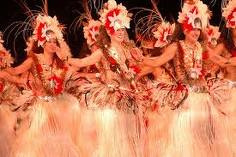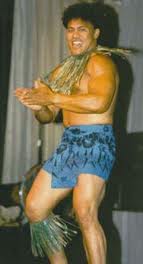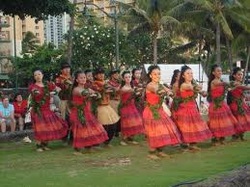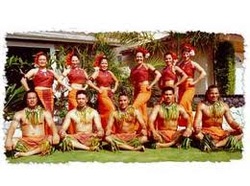
'ote'a
Many Polynesian dances stem from activities of their everyday lives, such as the 'ote'a from Tahiti and the Sasa from Samoa. In the Sasa men and women sit for most of the performance but there are times where they are required to stand. The main focus is the hand movements and requires synchronization of the whole group, which maybe the entire village. The hand movements are used to depict not only their daily actions but also the nature around them. The 'ote'a on the other hand is mainly focused on the hips. It is danced only to a fast rhythm by a drum and the hand movements are what show actions of everyday life. The men usually dance to themes such as war or sailing, while women dance to softer themes like the flight of a butterfly, or brushing their hair. The dancers wear grass skirts with tassels that help accentuate the hips and large headpieces.

Fa'ataupati
These dances tell not only express their daily lives they also show their view of the world around them, beautiful, elaborate, and even sensual. Many Polynesian dances also tell stories of events in their history that had significant importance. One such dance is the Samoan Fa'ataupati. It tells the story of an invasion of mosquitoes in the 19th century. This dance is only performed by men, and in the dance they slap themselves, like someone does after being bitten by a mosquitoes. They slap, clap, and stomp in synchronization. Many other islands wounds see this dance as a war dance.

Hula
The most commonly known story telling dance is the Hula from Hawaii. They both verbalize the story and show it through dance. Any chant or song used for hula is called a mele, the mele can be performed by the dancers as well as musicians around them. The actual dancing it's self is the hula. The costumes worn vary from very little clothing to a few layers of large skirts (they get really hot, trust me I've worn some).
I've seen my mom and aunts dance, I've seen videos of professionals and every time I watch it makes me wish I could dance like that. When I see the dance I see people embracing their heritage, I see people who saw beauty in everything. They saw the beauty of nature and sought to embrace it. They saw beauty in their own lives, they took something we see as meaningless activates and they see it as a dance.
I've read over and over again while researching that when westerners found the Polynesian Islands and first saw the dances of the people they were horrified by the lack of clothing and the movement of the pelvis. I understand what the western society was like back then but I just don't understand how they were unable to see the beauty in each move. But I suppose people are always skeptical of new things they don't understand.
By: Nikkol McCord
I've seen my mom and aunts dance, I've seen videos of professionals and every time I watch it makes me wish I could dance like that. When I see the dance I see people embracing their heritage, I see people who saw beauty in everything. They saw the beauty of nature and sought to embrace it. They saw beauty in their own lives, they took something we see as meaningless activates and they see it as a dance.
I've read over and over again while researching that when westerners found the Polynesian Islands and first saw the dances of the people they were horrified by the lack of clothing and the movement of the pelvis. I understand what the western society was like back then but I just don't understand how they were unable to see the beauty in each move. But I suppose people are always skeptical of new things they don't understand.
By: Nikkol McCord

